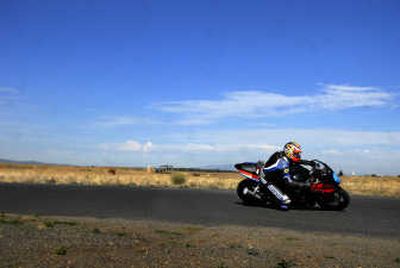Motorcycle racers get lesson in speed

Fourteen-year-old Brad Baker was having a little trouble keeping his backside where it belonged Thursday at Spokane Raceway Park.
To put it bluntly, his butt was on the wrong side of his motorcycle.
“If I’m not learning, I’m not happy,” Baker said when instructor Troy Cook pointed out the problem at the Mike Sullivan Motorcycle Road Racing & Performance Riding School.
Baker was among three dozen riders who came from around the Pacific Northwest and western Canada to get professional training in advance of this weekend’s Washington Motorcycle Road Racing Association races at the Spokane speedway.
It was the sixth time Sullivan has conducted his traveling school at Spokane Raceway Park. He’ll follow up today with a “track day,” in which riders, grouped according to speed, practice their skills informally.
After formal practice races Saturday and Sunday morning, racers in a dozen or more classes will compete Sunday afternoon until 5 p.m. Race director Jeff Wieand expects 300 to 400 racers and 500 to 700 spectators Sunday. Including friends and relatives who accompany racers, there could be up to 1,500 people at the raceway, Wieand said.
Those numbers were of interest to Jim Engle, who was on hand Thursday as a member of a committee that is advising Spokane County commissioners as they consider purchasing the raceway. The speedway is in court-ordered receivership and may be sold soon to repay investors.
Commissioners are interested in the three-track raceway’s potential for economic development as well as in preserving recreational opportunities. The complex is popular with sports car, stock car and drag racers, as well as a range of motorcyclists.
Motorcycles to be raced Sunday range from those with 1,000cc engines, capable of 180 mph, down to 160cc “vintage” models that may top out at less than 80 mph.
The vintage bikes, popular with older riders, offer some of the tightest racing and best entertainment, Wieand and Engle said.
“Those guys are fun to watch because they do the LeMans start,” Engle said. “It’s a spectacle to behold.”
When a gun fires, racers must run from the side of the track and start their bikes.
Another spectacle on Sunday’s racing bill is sidecar racing. Not the typical sidecars that attach to the sides of regular motorcycles, but three-wheeled, fiberglass-enclosed carts that resemble pregnant bobsleds.
Passengers, often the drivers’ wives, ride in little notches carved out of the bulging sides of the carts when they’re not moving around to keep their vehicles balanced. Sometimes they hang off the sides, with the seat of their pants barely off the pavement at speeds that can exceed those of the fastest motorcycles.
“It’s a big workout for the passengers,” Wieand said. “They really have to be in shape.”
Body English is important in all forms of motorcycle racing and is a big part of what Sullivan teaches.
He said student Brad Baker’s posterior-positioning problem sprang from the fact that the teenager is a champion dirt-track racer who’s trying to move into road racing.
Dirt bikes slide when cornering, so riders extend their inside legs and lean out on a turn. But road bikes stay planted, and riders achieve speed in corners by leaning into turns, Sullivan said.
In fact, road racers lean so far into a turn that they hang off the side of their bikes. Teflon “sliders” on their knees actually skim the pavement.
Sullivan said body positioning on corners is a big part of what he and his assistants – one for every five or six students – teach.
Most of his students are 18 or older, but Sullivan said he has confidence in Baker, who is a fellow Lewis County, Wash., resident. Baker has won three national and 10 West Coast championships as an amateur dirt track rider.
“If they were on dirt, none of these guys could come even close,” Baker’s father, Kip Baker, said as he watched his son and other students negotiate a turn.
So why switch to road racing?
“Money,” the elder Baker said, rubbing a thumb against his fingers. “Dirt tracks are our passion, but the money is in road racing.”
He estimated that Sullivan might win $5,000 to $7,000 in club-level races such as those planned Sunday. Sullivan is a five-time Washington Motorcycle Racing Association overall champion, and he won the Formula USA series national championship in 1999.
Baker said his family’s racing sponsor – PowerSports of Bremerton, Wash. – encouraged his son to seek one of 20 spots on the Red Bull national amateur racing team for teens born in 1992 through 1994.
Sullivan thinks Baker’s son has a good chance.